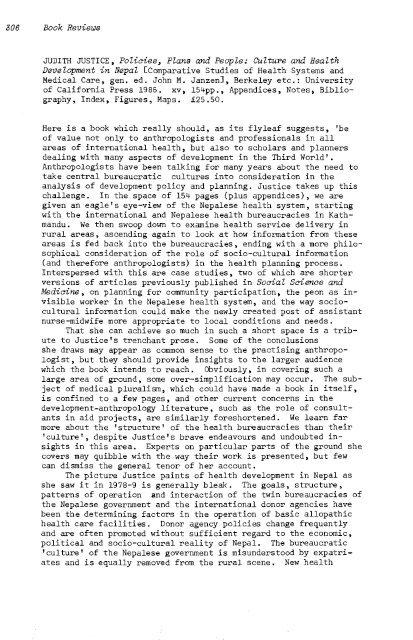CONTENTS NO.I - Institute of Social and Cultural Anthropology ...
CONTENTS NO.I - Institute of Social and Cultural Anthropology ...
CONTENTS NO.I - Institute of Social and Cultural Anthropology ...
Create successful ePaper yourself
Turn your PDF publications into a flip-book with our unique Google optimized e-Paper software.
306 Book Reviews<br />
JUDITH JUSTICE, Policies, Plans <strong>and</strong> People: CUltupe <strong>and</strong> Health<br />
Development in Nepal [Comparative Studies <strong>of</strong> Health Systems <strong>and</strong><br />
Medical Care, gen. ed. John M. Janzen], Berkeley etc.: University<br />
<strong>of</strong> California Press 1986. xv, 154pp., Appendices, Notes, Bibliography,<br />
Index, Figures, Maps. £25.50.<br />
Here is a book which really should, as its flyleaf suggests, 'be<br />
<strong>of</strong> value not only to anthropologists <strong>and</strong> pr<strong>of</strong>essionals in all<br />
areas <strong>of</strong> international health, but also to scholars <strong>and</strong> planners<br />
dealing with many aspects <strong>of</strong> development in the Third World'.<br />
Anthropologists have been talking for many years about the need to<br />
take central bureaucratic cultures into consideration in the<br />
analysis <strong>of</strong> development policy <strong>and</strong> planning. Justice takes up this<br />
challenge. In the space <strong>of</strong> 154 pages (plus appendices), we are<br />
given an eagle's eye-view <strong>of</strong> the Nepalese health system, starting<br />
with the international <strong>and</strong> Nepalese health bureaucracies in Kathm<strong>and</strong>u.<br />
We then swoop down to examine health serviae delivery in<br />
rural areas, ascending again to look at how information from these<br />
areas is fed back into the bureaucracies, ending with a more philosophical<br />
consideration <strong>of</strong> the role <strong>of</strong> socio-cultural information<br />
(<strong>and</strong> therefore anthropologists) in the health planning process.<br />
Interspersed with this are case studies, two <strong>of</strong> which are shorter<br />
versions <strong>of</strong> articles previously published in <strong>Social</strong> Science <strong>and</strong><br />
Medicine, on planning for community participation, the peon as invisible<br />
worker in the Nepalese health system, <strong>and</strong> the way sociocultural<br />
information could make the newly created post <strong>of</strong> assistant<br />
nurse-midwife more appropriate to local conditions <strong>and</strong> needs.<br />
That she can achieve so much in such a short space is a tribute<br />
to Justice's trenchant prose. Some <strong>of</strong> the conclusions<br />
she draws may appear as common sense to the practising anthropologist,<br />
but they should provide insights to the larger audience<br />
which the book intends to reach. Obviously, in covering such a<br />
large area <strong>of</strong> ground, some over-simplification may occur. The subject<br />
<strong>of</strong> medical pluralism, which could have made a book in itself,<br />
is confined to a few pages, <strong>and</strong> other current concerns in the<br />
development-anthropology literature, such as the role <strong>of</strong> consultants<br />
in aid projects, are similarly foreshortened. We learn far<br />
more about the 'structure' <strong>of</strong> the health bureaucracies than their<br />
'culture 1 , despite Justice's brave endeavours <strong>and</strong> undoubted insights<br />
in this area. Experts on particular parts <strong>of</strong> the ground she<br />
covers may quibble with the way their work is presented, but few<br />
can dismiss the general tenor <strong>of</strong> her account.<br />
The picture Justice paints <strong>of</strong> health development in Nepal as<br />
she saw it in 1978-9 is generally bleak. The goals, structure,<br />
patterns <strong>of</strong> operation <strong>and</strong> interaction <strong>of</strong> the twin bureaucracies <strong>of</strong><br />
the Nepalese government <strong>and</strong> the international donor agencies have<br />
been the determining factors in the operation <strong>of</strong> basic allopathic<br />
health care facilities. Donor agency policies change frequently<br />
<strong>and</strong> are <strong>of</strong>ten promoted without sufficient regard to the economic,<br />
political <strong>and</strong> socio-cultural reality <strong>of</strong> Nepal. The bureaucratic<br />
'culture' <strong>of</strong> the Nepalese government is misunderstood by expatriates<br />
<strong>and</strong> is equally removed from the rural scene. New health

















